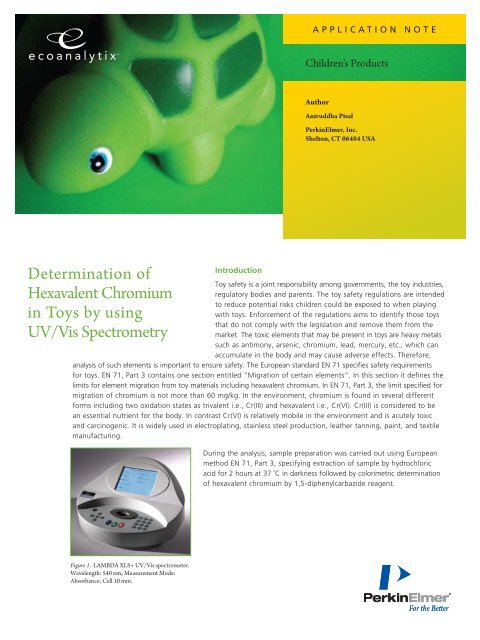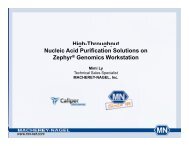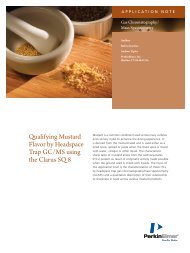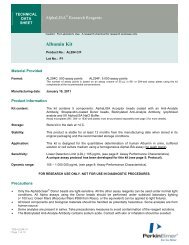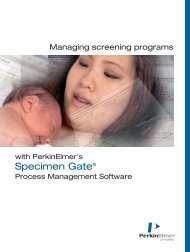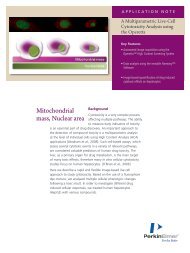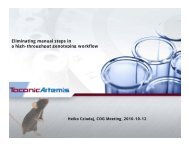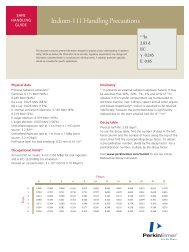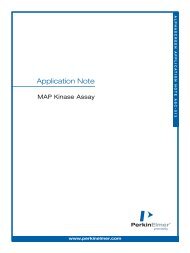Determination of Hexavalent Chromium in Toys by ... - PerkinElmer
Determination of Hexavalent Chromium in Toys by ... - PerkinElmer
Determination of Hexavalent Chromium in Toys by ... - PerkinElmer
Create successful ePaper yourself
Turn your PDF publications into a flip-book with our unique Google optimized e-Paper software.
application Note<br />
Children’s Products<br />
Author<br />
Aniruddha Pisal<br />
Perk<strong>in</strong>Elmer, Inc.<br />
Shelton, CT 06484 USA<br />
<strong>Determ<strong>in</strong>ation</strong> <strong>of</strong><br />
<strong>Hexavalent</strong> <strong>Chromium</strong><br />
<strong>in</strong> <strong>Toys</strong> <strong>by</strong> us<strong>in</strong>g<br />
UV/Vis Spectrometry<br />
Introduction<br />
Toy safety is a jo<strong>in</strong>t responsibility among governments, the toy <strong>in</strong>dustries,<br />
regulatory bodies and parents. The toy safety regulations are <strong>in</strong>tended<br />
to reduce potential risks children could be exposed to when play<strong>in</strong>g<br />
with toys. Enforcement <strong>of</strong> the regulations aims to identify those toys<br />
that do not comply with the legislation and remove them from the<br />
market. The toxic elements that may be present <strong>in</strong> toys are heavy metals<br />
such as antimony, arsenic, chromium, lead, mercury, etc., which can<br />
accumulate <strong>in</strong> the body and may cause adverse effects. Therefore,<br />
analysis <strong>of</strong> such elements is important to ensure safety. The European standard EN 71 specifies safety requirements<br />
for toys. EN 71, Part 3 conta<strong>in</strong>s one section entitled “Migration <strong>of</strong> certa<strong>in</strong> elements”. In this section it def<strong>in</strong>es the<br />
limits for element migration from toy materials <strong>in</strong>clud<strong>in</strong>g hexavalent chromium. In EN 71, Part 3, the limit specified for<br />
migration <strong>of</strong> chromium is not more than 60 mg/kg. In the environment, chromium is found <strong>in</strong> several different<br />
forms <strong>in</strong>clud<strong>in</strong>g two oxidation states as trivalent i.e., Cr(III) and hexavalent i.e., Cr(VI). Cr(III) is considered to be<br />
an essential nutrient for the body. In contrast Cr(VI) is relatively mobile <strong>in</strong> the environment and is acutely toxic<br />
and carc<strong>in</strong>ogenic. It is widely used <strong>in</strong> electroplat<strong>in</strong>g, sta<strong>in</strong>less steel production, leather tann<strong>in</strong>g, pa<strong>in</strong>t, and textile<br />
manufactur<strong>in</strong>g.<br />
Dur<strong>in</strong>g the analysis, sample preparation was carried out us<strong>in</strong>g European<br />
method EN 71, Part 3, specify<strong>in</strong>g extraction <strong>of</strong> sample <strong>by</strong> hydrochloric<br />
acid for 2 hours at 37 ˚C <strong>in</strong> darkness followed <strong>by</strong> colorimetric determ<strong>in</strong>ation<br />
<strong>of</strong> hexavalent chromium <strong>by</strong> 1,5-diphenylcarbazide reagent.<br />
Figure 1. LAMBDA XLS+ UV/Vis spectrometer.<br />
Wavelength: 540 nm; Measurement Mode:<br />
Absorbance; Cell 10 mm.
Experimental<br />
The analysis was carried out us<strong>in</strong>g Perk<strong>in</strong>Elmer ® LAMBDA <br />
XLS+ UV/Vis spectrometer as shown <strong>in</strong> Figure 1.<br />
Apparatus and reagents<br />
Table 1. List <strong>of</strong> apparatus and reagents used.<br />
pH meter<br />
Volumetric flasks, volume 100 mL<br />
Erlenmeyer flasks, volume 250 mL<br />
Water bath<br />
Boil<strong>in</strong>g chips<br />
Eppendorf ® micropipettes<br />
Sodium hydroxide, 1N<br />
Potassium dichromate, dried<br />
Nitric acid, concentrated<br />
Sulfuric acid, concentrated<br />
Sulfuric acid, 0.2 N<br />
Phosphoric acid, concentrated<br />
Hydrochloric acid, 0.1 M<br />
1,5 Diphenylcarbazide<br />
Acetone<br />
*The reagents, chemicals, standards used were <strong>of</strong> ACS grade.<br />
<strong>Chromium</strong> stock solution (500 mg/L): Dissolved 141.4 mg<br />
<strong>of</strong> potassium dichromate <strong>in</strong> water and diluted to 100 mL.<br />
<strong>Chromium</strong> standard solution (5 mg/L): Diluted 1.0 mL<br />
<strong>of</strong> above chromium stock solution to 100 mL.<br />
Diphenylcarbazide solution: Dissolved 250 mg <strong>of</strong><br />
1,5-diphenylcarbazide <strong>in</strong> 50 mL acetone and stored <strong>in</strong><br />
brown bottle.<br />
Series <strong>of</strong> reference solutions were prepared <strong>by</strong> pipett<strong>in</strong>g<br />
suitable volumes <strong>of</strong> above chromium standard solution,<br />
as shown <strong>in</strong> Table 2, <strong>in</strong>to 100-mL volumetric flasks.<br />
Table 2. Calibration solutions.<br />
Amount <strong>of</strong> chromium<br />
standard solution<br />
Concentration<br />
(5 mg/L) <strong>in</strong> 100 mL (mg/L)<br />
Blank – 0<br />
Absorbance measurement <strong>of</strong> calibration solutions:<br />
Background correction was performed with blank solution<br />
and absorbance <strong>of</strong> calibration reference solutions were<br />
measured at 540 nm us<strong>in</strong>g 10 mm cell. Figure 2 shows<br />
the calibration graph.<br />
Sample analysis: Different toy samples selected for analysis<br />
were, ‘yellow plastic’; ‘green fabric’ and ‘toy coated with<br />
pa<strong>in</strong>t’. 100 mg <strong>of</strong> test portion <strong>of</strong> sample was taken and cut<br />
<strong>in</strong>to small pieces. For toy sample with pa<strong>in</strong>t coat<strong>in</strong>g, the<br />
coat<strong>in</strong>g layer was scraped <strong>of</strong>f for analysis. The test portion<br />
so prepared was mixed for about 1 m<strong>in</strong>ute with 5 mL <strong>of</strong><br />
0.1 mol/L hydrochloric acid at 37 ˚C ±2 ˚C. pH <strong>of</strong> the solution<br />
was adjusted to between 1 and 1.5 with 2 mol/L hydrochloric<br />
acid. The mixture was protected from light, kept at 37 ˚C<br />
±2 ˚C and agitated for 1 hour cont<strong>in</strong>uously and then allowed<br />
to stand for 1 hour at 37 ˚C ±2 ˚C. Then the solution was<br />
filtered immediately through a membrane filter and diluted<br />
to about 90 mL with distilled water. The pH <strong>of</strong> the solution<br />
was adjusted to 2.0 ±0.5 us<strong>in</strong>g phosphoric acid and 0.2 N<br />
sulfuric acid. The solution was transferred to a 100-mL volumetric<br />
flask and diluted up to the mark with distilled water.<br />
2 mL <strong>of</strong> diphenylcarbazide solution was added to the<br />
solution and allowed to stand 10 m<strong>in</strong>utes for full color<br />
development. An appropriate portion was transferred to a 1 cm<br />
absorption cell and measured the absorbance at 540 nm<br />
with the blank as a reference.<br />
Results and discussion<br />
Calibration – l<strong>in</strong>earity<br />
The seven different levels <strong>of</strong> calibration standards were<br />
prepared <strong>in</strong> the range from 0.1 mg/L to 1.0 mg/L with<br />
reagent blank as first level. Results showed l<strong>in</strong>earity with<br />
a good correlation co-efficient <strong>of</strong> 0.9997. The calibration<br />
curve is shown <strong>in</strong> Figure 2.<br />
Spike recovery studies:<br />
A recovery study was performed at 0.5 mg/L concentration<br />
<strong>in</strong> three replicates. The results are summarized <strong>in</strong> Table 3.<br />
As seen <strong>in</strong> table, the recoveries are good, approximately<br />
105 percent. This demonstrates that the extraction is not<br />
caus<strong>in</strong>g transformation <strong>of</strong> the Cr(VI) spike to Cr(III).<br />
Reference 1 2 mL 0.10<br />
Reference 2 4 mL 0.20<br />
Reference 3 6 mL 0.40<br />
Reference 4 8 mL 0.60<br />
Reference 5 10 mL 0.80<br />
Reference 6 20 mL 1.00<br />
2
Table 3. Replicate spike recoveries.<br />
Sample<br />
% Recovery<br />
Sample 1 104.8<br />
Sample 2 104.6<br />
Sample 3 104.6<br />
Method detection limit: 10 replicate reagent blank solutions<br />
were prepared to make an estimate <strong>of</strong> method detection<br />
limit. To determ<strong>in</strong>e method detection limit, seven replicate<br />
aliquots <strong>of</strong> fortified reagent water (0.01 mg/L) were prepared<br />
and processed through entire analytical method.<br />
The method detection limit was calculated as follows,<br />
MDL = (t) X (s) where,<br />
t = student’s t value for a 99% confidence level and a<br />
standard deviation estimate with n-1 degrees <strong>of</strong> freedom.<br />
[t = 3.143 for seven replicates].<br />
s = standard deviation <strong>of</strong> replicate analyses.<br />
The method detection limit found to be 0.003 mg/L.<br />
Sample analysis: Results obta<strong>in</strong>ed for different toy samples<br />
are presented <strong>in</strong> Table 4. The yellow pa<strong>in</strong>t exceeds the limit<br />
specified <strong>in</strong> the current standard for total chromium (60 mg/Kg).<br />
The anticipated revision to the EU standard recommends a<br />
limit <strong>of</strong> 0.02 mg/Kg hexavalent chromium <strong>in</strong> a dry, brittle or<br />
pliable toy, much lower than the current standard and based<br />
on the species. The detection limit measured here is sufficient<br />
for the new regulatory level if a larger sample is taken for<br />
extraction or a smaller dilution is used.<br />
Table 4. Sample analysis results (calculations are based on total<br />
amount extracted and dilution factor).<br />
Sample Cr +6 – Total <strong>Chromium</strong> –<br />
UV result (mg/Kg) ICP result (mg/Kg)<br />
Yellow Plastic 5.4 29.9<br />
Green Fabric ND 2.6<br />
Blue Pa<strong>in</strong>t-1 7.2 89.5<br />
Blue Pa<strong>in</strong>t-2 11 66.9<br />
Yellow Pa<strong>in</strong>t-1 430 1790<br />
Yellow Pa<strong>in</strong>t-2 360 1870<br />
Red Pa<strong>in</strong>t-1 ND 58.4<br />
Red Pa<strong>in</strong>t-2 ND 47.4<br />
*ND: not detected<br />
Figure 2. Calibration graph.<br />
The total amount <strong>of</strong> chromium <strong>in</strong> the extracts was measured<br />
us<strong>in</strong>g Inductively Coupled Plasma Optical Emission Spectroscopy<br />
(ICP-OES) with result<strong>in</strong>g values <strong>in</strong> Table 4. S<strong>in</strong>ce the total<br />
chromium value is made up <strong>of</strong> both Cr(III) and Cr(VI) this is<br />
a good <strong>in</strong>dication <strong>of</strong> the maximum amount <strong>of</strong> Cr(VI) that<br />
might be present. This provides an order-<strong>of</strong>-magnitude<br />
confirmation <strong>of</strong> the analysis.<br />
PAINT-COATED TOY<br />
Figure 3. Toy samples.<br />
GREEN FABRIC<br />
Yellow Plastic<br />
3
Conclusion<br />
The LAMBDA XLS+ UV/Vis spectrometer can be used to<br />
measure Cr(VI) contents <strong>in</strong> toys. The detection limit is sufficient<br />
to determ<strong>in</strong>e Cr(VI) at low levels and can be improved <strong>by</strong><br />
tak<strong>in</strong>g a larger sample for extraction and reduc<strong>in</strong>g the dilution<br />
factor if the new revisions to EN 71 require it. L<strong>in</strong>earity and<br />
spike recoveries further validate the performance <strong>of</strong> this<br />
methodology.<br />
The sample extraction used here may not be representative<br />
<strong>of</strong> the extraction that may be recommended <strong>in</strong> the f<strong>in</strong>al revision<br />
<strong>of</strong> EN 71 specifically for Cr(VI), but represents a reasonable<br />
approach to demonstrate the result<strong>in</strong>g analysis.<br />
Overall, the capability to measure Cr(VI) us<strong>in</strong>g the UV/Vis<br />
procedure with the LAMBDA XLS+ has been successfully<br />
demonstrated.<br />
References<br />
1. Standard Methods for the Exam<strong>in</strong>ation <strong>of</strong> Water and<br />
Wastewater”, Method 3500-Cr, American Public Health<br />
Association.<br />
2. EN 71-3:1995 Safety <strong>of</strong> <strong>Toys</strong> – Part 3 Migration <strong>of</strong> certa<strong>in</strong><br />
elements.<br />
3. 40 CFR, Part-136 Appendix B – Def<strong>in</strong>ition and Procedure<br />
for the <strong>Determ<strong>in</strong>ation</strong> <strong>of</strong> the Method Detection Limit.<br />
Perk<strong>in</strong>Elmer, Inc.<br />
940 W<strong>in</strong>ter Street<br />
Waltham, MA 02451 USA<br />
P: (800) 762-4000 or<br />
(+1) 203-925-4602<br />
www.perk<strong>in</strong>elmer.com<br />
For a complete list<strong>in</strong>g <strong>of</strong> our global <strong>of</strong>fices, visit www.perk<strong>in</strong>elmer.com/ContactUs<br />
Copyright ©2009, Perk<strong>in</strong>Elmer, Inc. All rights reserved. Perk<strong>in</strong>Elmer ® is a registered trademark <strong>of</strong> Perk<strong>in</strong>Elmer, Inc. All other trademarks are the property <strong>of</strong> their respective owners.<br />
008766_01


